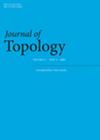求助PDF
{"title":"霍奇规范的第二种变化和更高的普赖姆表征","authors":"Vladimir Marković, Ognjen Tošić","doi":"10.1112/topo.12322","DOIUrl":null,"url":null,"abstract":"<p>Let <span></span><math>\n <semantics>\n <mrow>\n <mi>χ</mi>\n <mo>∈</mo>\n <msup>\n <mi>H</mi>\n <mn>1</mn>\n </msup>\n <mrow>\n <mo>(</mo>\n <msub>\n <mi>Σ</mi>\n <mi>h</mi>\n </msub>\n <mo>,</mo>\n <mi>Q</mi>\n <mo>)</mo>\n </mrow>\n </mrow>\n <annotation>$\\chi \\in H^1(\\Sigma _h,\\mathbb {Q})$</annotation>\n </semantics></math> denote a rational cohomology class, and let <span></span><math>\n <semantics>\n <msub>\n <mo>H</mo>\n <mi>χ</mi>\n </msub>\n <annotation>$\\operatorname{H}_\\chi$</annotation>\n </semantics></math> denote its Hodge norm. We recover the result that <span></span><math>\n <semantics>\n <msub>\n <mo>H</mo>\n <mi>χ</mi>\n </msub>\n <annotation>$\\operatorname{H}_\\chi$</annotation>\n </semantics></math> is a plurisubharmonic function on the Teichmüller space <span></span><math>\n <semantics>\n <msub>\n <mi>T</mi>\n <mi>h</mi>\n </msub>\n <annotation>${\\mathcal {T}}_h$</annotation>\n </semantics></math>, and characterize complex directions along which the complex Hessian of <span></span><math>\n <semantics>\n <msub>\n <mo>H</mo>\n <mi>χ</mi>\n </msub>\n <annotation>$\\operatorname{H}_\\chi$</annotation>\n </semantics></math> vanishes. Moreover, we find examples of <span></span><math>\n <semantics>\n <mrow>\n <mi>χ</mi>\n <mo>∈</mo>\n <msup>\n <mi>H</mi>\n <mn>1</mn>\n </msup>\n <mrow>\n <mo>(</mo>\n <msub>\n <mi>Σ</mi>\n <mi>h</mi>\n </msub>\n <mo>,</mo>\n <mi>Q</mi>\n <mo>)</mo>\n </mrow>\n </mrow>\n <annotation>$\\chi \\in H^1(\\Sigma _{h},\\mathbb {Q})$</annotation>\n </semantics></math> such that <span></span><math>\n <semantics>\n <msub>\n <mo>H</mo>\n <mi>χ</mi>\n </msub>\n <annotation>$\\operatorname{H}_\\chi$</annotation>\n </semantics></math> is not strictly plurisubharmonic. As part of this construction, we find an unbranched covering <span></span><math>\n <semantics>\n <mrow>\n <mi>π</mi>\n <mo>:</mo>\n <msub>\n <mi>Σ</mi>\n <mi>h</mi>\n </msub>\n <mo>→</mo>\n <msub>\n <mi>Σ</mi>\n <mn>2</mn>\n </msub>\n </mrow>\n <annotation>$\\pi:\\Sigma _{h}\\rightarrow \\Sigma _2$</annotation>\n </semantics></math> such that the subgroup of <span></span><math>\n <semantics>\n <mrow>\n <msub>\n <mi>H</mi>\n <mn>1</mn>\n </msub>\n <mrow>\n <mo>(</mo>\n <msub>\n <mi>Σ</mi>\n <mi>h</mi>\n </msub>\n <mo>,</mo>\n <mi>Q</mi>\n <mo>)</mo>\n </mrow>\n </mrow>\n <annotation>$H_1(\\Sigma _{h},\\mathbb {Q})$</annotation>\n </semantics></math> generated by lifts of simple curves from <span></span><math>\n <semantics>\n <msub>\n <mi>Σ</mi>\n <mn>2</mn>\n </msub>\n <annotation>$\\Sigma _2$</annotation>\n </semantics></math> is strictly contained in <span></span><math>\n <semantics>\n <mrow>\n <msub>\n <mi>H</mi>\n <mn>1</mn>\n </msub>\n <mrow>\n <mo>(</mo>\n <msub>\n <mi>Σ</mi>\n <mi>h</mi>\n </msub>\n <mo>,</mo>\n <mi>Q</mi>\n <mo>)</mo>\n </mrow>\n </mrow>\n <annotation>$H_1(\\Sigma _{h},\\mathbb {Q})$</annotation>\n </semantics></math>. Finally, combining the characterization theorem with the Riemann–Roch, and the Li–Yau [Invent. Math. 69 (1982), no. 2, 269–291] gonality estimate, we show that geometrically uniform covers of <span></span><math>\n <semantics>\n <msub>\n <mi>Σ</mi>\n <mi>g</mi>\n </msub>\n <annotation>$\\Sigma _g$</annotation>\n </semantics></math> satisfy the Putman–Wieland Conjecture about the induced Higher Prym representations. </p>","PeriodicalId":56114,"journal":{"name":"Journal of Topology","volume":"17 1","pages":""},"PeriodicalIF":1.1000,"publicationDate":"2024-01-30","publicationTypes":"Journal Article","fieldsOfStudy":null,"isOpenAccess":false,"openAccessPdf":"","citationCount":"0","resultStr":"{\"title\":\"The second variation of the Hodge norm and higher Prym representations\",\"authors\":\"Vladimir Marković, Ognjen Tošić\",\"doi\":\"10.1112/topo.12322\",\"DOIUrl\":null,\"url\":null,\"abstract\":\"<p>Let <span></span><math>\\n <semantics>\\n <mrow>\\n <mi>χ</mi>\\n <mo>∈</mo>\\n <msup>\\n <mi>H</mi>\\n <mn>1</mn>\\n </msup>\\n <mrow>\\n <mo>(</mo>\\n <msub>\\n <mi>Σ</mi>\\n <mi>h</mi>\\n </msub>\\n <mo>,</mo>\\n <mi>Q</mi>\\n <mo>)</mo>\\n </mrow>\\n </mrow>\\n <annotation>$\\\\chi \\\\in H^1(\\\\Sigma _h,\\\\mathbb {Q})$</annotation>\\n </semantics></math> denote a rational cohomology class, and let <span></span><math>\\n <semantics>\\n <msub>\\n <mo>H</mo>\\n <mi>χ</mi>\\n </msub>\\n <annotation>$\\\\operatorname{H}_\\\\chi$</annotation>\\n </semantics></math> denote its Hodge norm. We recover the result that <span></span><math>\\n <semantics>\\n <msub>\\n <mo>H</mo>\\n <mi>χ</mi>\\n </msub>\\n <annotation>$\\\\operatorname{H}_\\\\chi$</annotation>\\n </semantics></math> is a plurisubharmonic function on the Teichmüller space <span></span><math>\\n <semantics>\\n <msub>\\n <mi>T</mi>\\n <mi>h</mi>\\n </msub>\\n <annotation>${\\\\mathcal {T}}_h$</annotation>\\n </semantics></math>, and characterize complex directions along which the complex Hessian of <span></span><math>\\n <semantics>\\n <msub>\\n <mo>H</mo>\\n <mi>χ</mi>\\n </msub>\\n <annotation>$\\\\operatorname{H}_\\\\chi$</annotation>\\n </semantics></math> vanishes. Moreover, we find examples of <span></span><math>\\n <semantics>\\n <mrow>\\n <mi>χ</mi>\\n <mo>∈</mo>\\n <msup>\\n <mi>H</mi>\\n <mn>1</mn>\\n </msup>\\n <mrow>\\n <mo>(</mo>\\n <msub>\\n <mi>Σ</mi>\\n <mi>h</mi>\\n </msub>\\n <mo>,</mo>\\n <mi>Q</mi>\\n <mo>)</mo>\\n </mrow>\\n </mrow>\\n <annotation>$\\\\chi \\\\in H^1(\\\\Sigma _{h},\\\\mathbb {Q})$</annotation>\\n </semantics></math> such that <span></span><math>\\n <semantics>\\n <msub>\\n <mo>H</mo>\\n <mi>χ</mi>\\n </msub>\\n <annotation>$\\\\operatorname{H}_\\\\chi$</annotation>\\n </semantics></math> is not strictly plurisubharmonic. As part of this construction, we find an unbranched covering <span></span><math>\\n <semantics>\\n <mrow>\\n <mi>π</mi>\\n <mo>:</mo>\\n <msub>\\n <mi>Σ</mi>\\n <mi>h</mi>\\n </msub>\\n <mo>→</mo>\\n <msub>\\n <mi>Σ</mi>\\n <mn>2</mn>\\n </msub>\\n </mrow>\\n <annotation>$\\\\pi:\\\\Sigma _{h}\\\\rightarrow \\\\Sigma _2$</annotation>\\n </semantics></math> such that the subgroup of <span></span><math>\\n <semantics>\\n <mrow>\\n <msub>\\n <mi>H</mi>\\n <mn>1</mn>\\n </msub>\\n <mrow>\\n <mo>(</mo>\\n <msub>\\n <mi>Σ</mi>\\n <mi>h</mi>\\n </msub>\\n <mo>,</mo>\\n <mi>Q</mi>\\n <mo>)</mo>\\n </mrow>\\n </mrow>\\n <annotation>$H_1(\\\\Sigma _{h},\\\\mathbb {Q})$</annotation>\\n </semantics></math> generated by lifts of simple curves from <span></span><math>\\n <semantics>\\n <msub>\\n <mi>Σ</mi>\\n <mn>2</mn>\\n </msub>\\n <annotation>$\\\\Sigma _2$</annotation>\\n </semantics></math> is strictly contained in <span></span><math>\\n <semantics>\\n <mrow>\\n <msub>\\n <mi>H</mi>\\n <mn>1</mn>\\n </msub>\\n <mrow>\\n <mo>(</mo>\\n <msub>\\n <mi>Σ</mi>\\n <mi>h</mi>\\n </msub>\\n <mo>,</mo>\\n <mi>Q</mi>\\n <mo>)</mo>\\n </mrow>\\n </mrow>\\n <annotation>$H_1(\\\\Sigma _{h},\\\\mathbb {Q})$</annotation>\\n </semantics></math>. Finally, combining the characterization theorem with the Riemann–Roch, and the Li–Yau [Invent. Math. 69 (1982), no. 2, 269–291] gonality estimate, we show that geometrically uniform covers of <span></span><math>\\n <semantics>\\n <msub>\\n <mi>Σ</mi>\\n <mi>g</mi>\\n </msub>\\n <annotation>$\\\\Sigma _g$</annotation>\\n </semantics></math> satisfy the Putman–Wieland Conjecture about the induced Higher Prym representations. </p>\",\"PeriodicalId\":56114,\"journal\":{\"name\":\"Journal of Topology\",\"volume\":\"17 1\",\"pages\":\"\"},\"PeriodicalIF\":1.1000,\"publicationDate\":\"2024-01-30\",\"publicationTypes\":\"Journal Article\",\"fieldsOfStudy\":null,\"isOpenAccess\":false,\"openAccessPdf\":\"\",\"citationCount\":\"0\",\"resultStr\":null,\"platform\":\"Semanticscholar\",\"paperid\":null,\"PeriodicalName\":\"Journal of Topology\",\"FirstCategoryId\":\"100\",\"ListUrlMain\":\"https://londmathsoc.onlinelibrary.wiley.com/doi/10.1112/topo.12322\",\"RegionNum\":2,\"RegionCategory\":\"数学\",\"ArticlePicture\":[],\"TitleCN\":null,\"AbstractTextCN\":null,\"PMCID\":null,\"EPubDate\":\"\",\"PubModel\":\"\",\"JCR\":\"Q2\",\"JCRName\":\"MATHEMATICS\",\"Score\":null,\"Total\":0}","platform":"Semanticscholar","paperid":null,"PeriodicalName":"Journal of Topology","FirstCategoryId":"100","ListUrlMain":"https://londmathsoc.onlinelibrary.wiley.com/doi/10.1112/topo.12322","RegionNum":2,"RegionCategory":"数学","ArticlePicture":[],"TitleCN":null,"AbstractTextCN":null,"PMCID":null,"EPubDate":"","PubModel":"","JCR":"Q2","JCRName":"MATHEMATICS","Score":null,"Total":0}
引用次数: 0
引用
批量引用


 求助内容:
求助内容: 应助结果提醒方式:
应助结果提醒方式:


